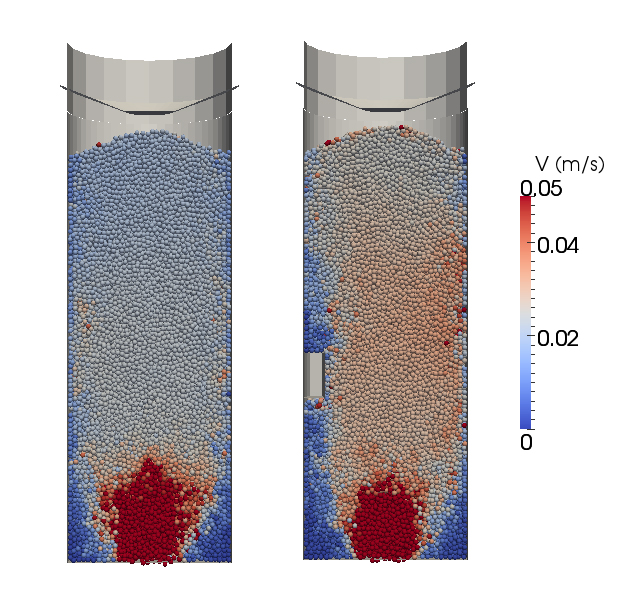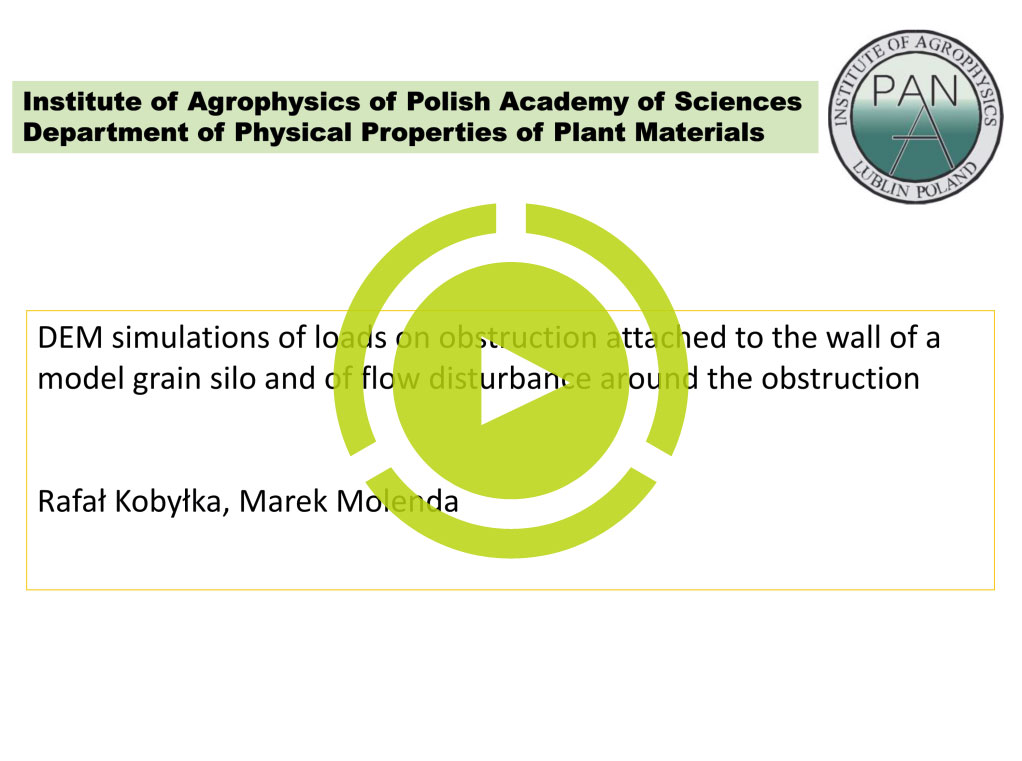Discrete Element Method (DEM) is one of the numerical approaches able to evaluate trajectories of movement and mutual interactions between particles inside beds of granular materials (e.g. cereal grains, sand, powders etc.). DEM, because of its potential, earned a common acceptance as a useful tool for description of many engineering problems concerning with powdery materials, for example calculation of stress distribution inside the silo, mixing and grinding. The simplest scheme of DEM is presented at the scheme below:
DEM simulations of flow disturbance around the obstruction.
Fig. 1. Frames from the numerical simulations of discharge of the granular material from cylindrical container without (left) and with insert attached to the silo wall (right). Axial cross-section of a bin with diameter of 0.12 m and height of 0.33 m filled with 75000 spherical particles.
In storage bins there is often a necessity to place an additional construction elements inside the material bed (sensors, feeder covers, stress relieving pipes etc.). The disturbance of stress distribution caused by existence of such elements may lead, in extreme cases, to damaging the whole construction of the silo. Fig. 1 depicts the way in which the flow pattern is affected by the placement of an additional element inside the model silo.
W zbiornikach przechowalniczych często istnieje konieczność umieszczania dodatkowych elementów wewnątrz złoża (czujniki, osłony podajników, rury odciążające itp.). Zaburzenia rozkładu naprężeń powodowane przez takie elementy mogą prowadzić w skrajnych przypadkach do uszkodzenia całej konstrukcji zbiornika. Rys. 1 przedstawia sposób, w jaki zmienia się charakter wypływu materiału sypkiego w modelowym silosie po zamontowaniu półki przy ścianie.
Kobyłka R., Molenda M.: DEM simulations of loads on obstruction attached to the wall of a model grain silo and of flow disturbance around the obstruction (2014 r.) Powder Technology 2014, Vol. 256, 210-216
The effect of the particle size distribution on the micro- and macromechanical properties of granular materials.
Most particle packings involved in industrial and natural processes is comprise of a broad range of particle sizes. The degree of particle size heterogeneity determines the geometrical and micromechanical properties of packings during mixing and discharge processes, as well as their mechanical response to external loads due to tableting, granulation et al.. The 3-D simulations were conducted for polydisperse packings composed of spheres with various degrees of particle size polydispersity and with particle size distributions approximated by normal, arbitrary and uniform distribution functions, using the discrete element method (Fig. 1). The analysis of the geometrical and mechanical properties of packings subjected to different compressive loads showed slight effect of the shape of particle size distribution (PSD) on the porosity of sample and no effect of PSD on the micro- and macromechanical properties of granular materials. The porosity, stiffness of granular packings and pressure ratio in samples were found to increase with increasing standard deviation of particle mean diameter. The increase in the degree of polydispersity of particulate assemblages resulted in decrease in the average coordination number (Fig. 2).
Większość materiałów sypkich stanowi ośrodki niejednorodne pod względem wielkości cząstek, a stopień ich polidyspersyjności determinuje zachowanie materiałów w procesach mieszania i opróżniania zbiorników przemysłowych oraz reakcję materiałów poddanych obciążeniom podczas procesów tabletkowania, granulowania i innych.
Zastosowanie Metody Elementów Dyskretnych umożliwiło przeprowadzenie badań nad materiałami o różnym stopniu niejednorodności wielkości cząstek, charakteryzującymi się różnymi rozkładami wymiarów granul (normalnym, przypadkowym i jednorodnym). Analiza geometrycznych i mechanicznych właściwości modelowanych ośrodków, poddanych testowi jednoosiowego ściskania (Rys. 1), wykazała niewielki wpływ rodzaju rozkładu wielkości cząstek na porowatość ośrodków rozdrobnionych oraz jego brak na mikro- i makromechaniczne właściwości próbek. Wraz ze wzrostem standardowego odchylenia średnicy sfer obserwowano wzrost porowatości złóż, ich sztywności oraz ilorazu naporu. Wzrost stopnia polidyspersyjności wielkości cząstek prowadził do spadku liczby koordynacyjnej w modelowanych próbkach (Rys. 2).
Fig. 1. Initial configuration of polydisperse sample with standard deviation of particle mean diameter of 40%.
Fig. 2. Average coordination numbers for samples with normal particle size distribution and various standard deviations of particle mean diameters.


















